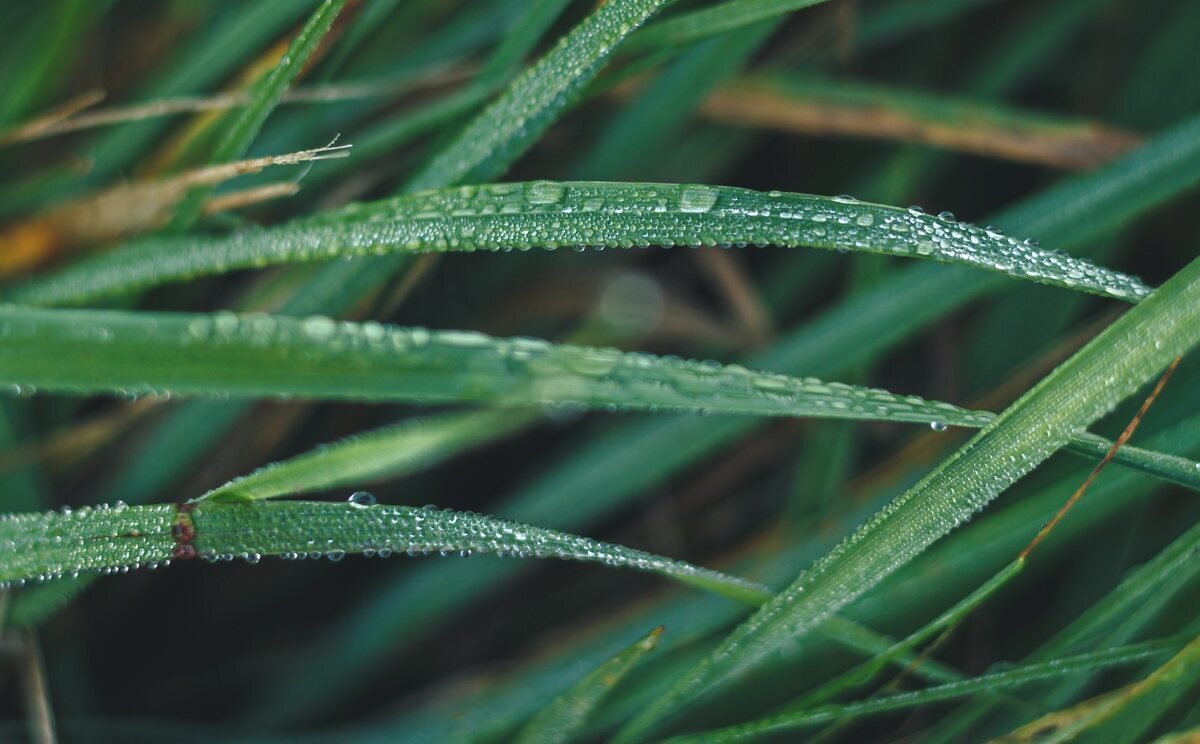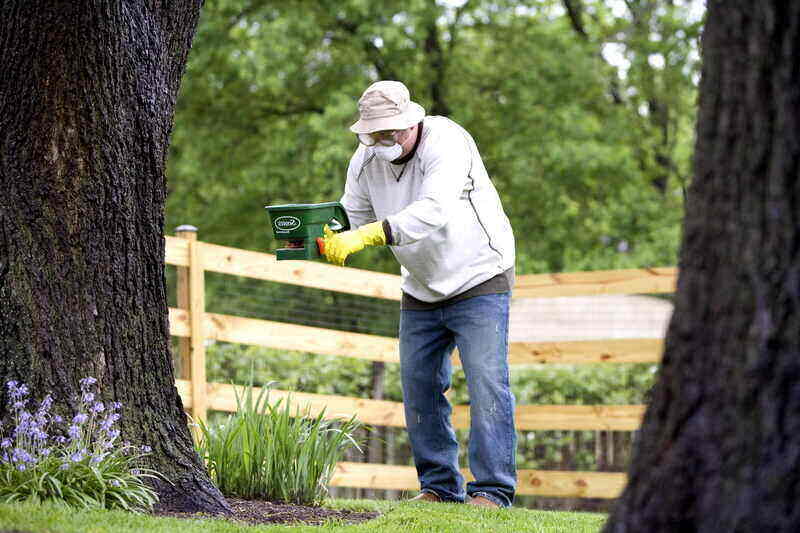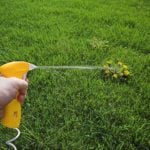
Do you know your Peruvian bat guano from your liquid kelp? If so, chances are you’re already a fan of organic lawn care. This is your guide to everything you need to know about organic lawn fertilizer.
- What is Organic Fertilizer?
- Organic Lawn Fertilizer: Pros and Cons
- Organic Lawn Fertilizer NPK Ratios
- Synthetic Lawn Fertilizer: Pros and Cons
- History of Organic Lawn Care
- What Organic Lawn Care Is
- What Organic Lawn Care Is Not
- 9 Best Practices for Organic Lawn Care
- FAQs: Organic Lawn Fertilizer
- When to Call a Professional
What is Organic Fertilizer?

Organic fertilizers are substances composed of natural, carbon-containing materials designed to improve the health of your soil. They contain components derived from plants, animals, or fish, such as decomposing leaves, broken shells or fish, animal manure, and composted food.
Chemical fertilizers, usually referred to as inorganic or synthetic fertilizers, are typically synthesized from natural gas, rock fragments, and nitrogen gas. A few of the resulting synthetic fertilizers are ammonium nitrate, ammonium phosphate, and potassium sulfate.
Organic fertilizers offer a more controlled intake of nutrients by delivering them gradually. Healthy, chemical-free soil develops resilient turf that looks fantastic. You’ll probably save money on lawn maintenance supplies in the long run.
“I think synthetic fertilizers have run their course,” says Nate Clemmer, CEO of Philadelphia-based Branch Creek Lawn, a producer of organic lawn care products.
Note: Not all organic (carbon-containing) fertilizers can be used for certified organic food production. However, the Organic Materials Review Institute (OMRI) offers an independent review of products, including fertilizers, to signify that they are suitable in certified organic production. You may see the OMRI logo on some organic fertilizers.
Products Table:
Short on time? Here are the four top-rated organic lawn fertilizers.
Organic Lawn Fertilizer: Pros and Cons
Pros
Organic lawn fertilizers are made from organic matter that contributes to a healthy lawn.
✔ Delivers nutrients: The organic matter breaks down slowly to and supplies nutrients to your grass.
✔ Improves soil structure: The organic matter boosts the soil’s ability to use water efficiently.
✔ Encourages beneficial microbes: These naturally occurring bacteria, fungi, and microorganisms break down organic matter into chemicals that roots can absorb.
✔ Attracts beneficial insects: Larger predator insects, like dragonflies, ladybugs, and spiders will eat nuisance bugs. Organic fertilizers also encourage the growth of microorganisms and fungi, which attract earthworms.
Organic fertilizers can be more expensive than synthetic fertilizers, but their use reduces your lawn’s need for nutrients and pesticides.

Cons
“One major disadvantage of organic fertilizers is that they tend to be bulky compared to chemical fertilizers. So more pounds of the product must be applied to deliver the same amount of actual nutrients,” states the Ohio State University Extension.
Here are a few other disadvantages of organic lawn fertilizer:
✘ It’s inconsistent: Many organic fertilizers break down at different times and produce irregular results.
✘ Takes time: Because organic fertilizers decompose slowly, the advantages may not be apparent for months, so don’t expect a green lawn right away. It is a process, not an event.
“They work at Mother Nature’s speed,” says Ron Neitzel, author of “The Green Wizard’s Guide”. ““The synthetics are able to work their way into the grass much quicker.”
✘ They stink: Some of them do, anyway. Fish emulsion products can leave your lawn smelling like decaying fish. Plus, you may need a higher rate of organic fertilizers to be effective, phew!
Organic Lawn Fertilizer N-P-K Ratios

These are general N-P-K values and will vary by the source of the product. You can buy these online or at your local garden center.
| Organic Lawn Fertilizers | ||||
|---|---|---|---|---|
| Organic fertilizer | Nitrogen (N%) | Potassium (P%) | Phosphorus (K%) | Pounds of product needed for 1 number of N |
| Alfalfa pellets | 5 | 1 | 2 | 20 |
| Blood meal | 10 | 1 | 0 | 10 |
| Blood meal, steamed | 3 | 15 | 0 | 33 |
| Composted chicken manure | 0.5 | 0.3 | 0.5 | 200 |
| Composted cow manure | 0.5 | 0.3 | 0.5 | 200 |
| Cottonseed meal | 3 | 1 | 1 | 33 |
| Feather meal | 12 | 0 | 0 | 8 |
| Fish pellets | 7 | 7 | 2 | 14 |
| Greensand | 0 | 1 | 6 | NA |
| Kelp meal | 2 | 1 | 3 | 50 |
| Organic pellets (various ingredients) | 6 | 6 | 6 | 16 |
| Corn gluten meal | 10 | 0 | 0 | 10 |
| Seabird guano | 12 | 8 | 2 | 8 |
| Shellfish fertilizer | 3 | 3 | 1 | 33 |
| Soybean meal | 7 | 1 | 3 | 14 |
| Erth Food | 1.5 | 0.5 | 0.5 | 33 |
| Milorganite | 6 | 4 | 0 | 16 |
| ReVita Compost Plus | 3 | 4 | 3 | 33 |
| These are general N-P-K values and will vary by source of product. | ||||
Synthetic Lawn Fertilizer: Pros and Cons
Pros
These traditional fertilizers give your lawn a large, quick dose of synthetic nitrogen (N), phosphorus (P), and potassium (K).
✔ Fast-acting: The Scotts Liquid Turf Builder, for example, boasts that its quick shot of nitrogen can green up a lawn in as few as 24 hours.
✔ Homogenous: These products break down in a predictable and consistent way. This enables a uniform application to your lawn.
Cons
Overuse can lead to fertilizer burn, particularly with fast-release, water-soluble formulas.
✘ Is a contamination risk: Their runoff is bad for bodies of water.
“These nutrients have been linked to eutrophication, a biological process in ponds, lakes, and streams where excessive seasonal algal growth occurs,” according to the Purdue Extension. “In severe cases, the algae deplete oxygen levels, which may kill fish.”
✘ Causes fertilizer burn: Leaves grass plants scorched, turning yellow or brown due to the presence of nitrogen salts. The problem occurs, most often in hot weather or when the fertilizer wasn’t watered in.
✘ Kills soil microorganisms: These tiny creatures hide in the soil and are necessary to break down nutrients into a form the grass can use
History of Organic Lawn Care
When it comes to synthetic fertilizers, “People are beginning to question what they’re putting down, why they’re putting it down, and now we have alternatives,” says Charles “Chip” Osborne, Jr., President of Osborne Organics of Marblehead, Mass., and founder of the Organic Landscape Association. As far as synthetics go, “I don’t need them. We can grow without them.”
The Rise of Synthetics
Following WWII, synthetic fertilizers created from natural gas surged into agricultural use. They increased crop yields and fed billions. Their use expanded to home lawn and garden care. With manufacturer encouragement, conventional lawn care in the United States became a series of cyclical chemical applications.
But that has created problems. Nitrogen and phosphorus runoff from fertilizers, particularly in their fast-release form, have caused such environmental damage that 25 states have limited fertilizer use. And on an individual lawn level, synthetic fertilizers work against natural soil health.
An Alternative Option
In reaction, organic lawn care began to take root. In the early 1990s, a trio of Yale University researchers wrote “Redesigning the American Lawn,” in which they advocated for what they called “The Freedom Lawn,” a minimally maintained lawn allowing any plant to grow. No fertilizer, no watering — just an occasional mow.
“I’m not a Luddite,” the 81-year-old Bormann told an interviewer in 2003. “I recognize the use of fertilizers, pesticides, and genetic engineering as being important components of how our society works. But it’s just the notion that there’s no limit to it — and if we get in trouble we’ll fix it — that concerns me.”
Over the years, as environmental damage caused by nitrogen and phosphorus runoff became clear, the concept developed. Today, any online search for organic lawn care service will find plenty of offerings. There are multiple training programs and organizations for lawn care companies’ workers to learn the practice.
What Organic Lawn Care Is

Organic lawn care is simply taking care of your grass without using synthetic fertilizers, pesticides, or weed killers.
- Soil-based approach: Soil testing is the basis for making changes. The soil, in turn, feeds the plant. “We’re taking a ‘feed the soil’ approach as opposed to a ‘feed the plant’ approach,” Osborne says.
He continues, “If you are using an organic fertilizer, you are feeding the microbial life in the soil with that fertilizer, and then that microbial life is breaking it down to the form the plant can use, and you are building that biomass.”
- It’s a process: Organic lawn care means more than just switching out chemical-based products for natural ones. It’s a combination of different methods. The goal is to improve the conditions for healthy development while reducing the chance of weeds and disease.
For example, if crabgrass shows up, the conventional treatment is to apply a synthetic pre-emergent weed killer in the early spring — every spring.
The organic approach encourages a healthier, taller lawn so that crabgrass gets crowded out and new seeds don’t sprout. (Corn gluten meal, a byproduct of the corn milling process, is an organic pre-emergent alternative.)
Organic lawn care takes a long-range view of lawn health and looks for solutions rather than quick fixes.
What Organic Lawn Care Is Not
Organic lawn care is not:
- Not maintenance-free: Simply skipping lawn maintenance won’t have the best results. Like any regimen, going organic will require an investment of time and money, so it’s wrong to think, “I do nothing, therefore I am organic.”
The “Freedom Lawns”, for example, are less effective in preventing fertilizer pollution because they develop big bare spots and allow runoff.
- Not a quick fix: The downside of organic lawn care is that it does not deliver the near-instant green-up that synthetic fertilizers do. It will take months, if not years, to transition from conventional lawn care to organic lawn care.
Clemmer likens the process to the transition a drug addict makes to sobriety. “When a lawn has been jacked up on synthetic fertilizers for years, there needs to be a transitionary period.”
- Not entirely “green”: There’s a higher ratio of phosphorus to nitrogen in some (not all) organic fertilizers, so you may have to use more fertilizer to get the nitrogen your grass needs. The concern is that excessive use of any fertilizer can contaminate the water that flows into storm drains and natural bodies of water.
Excess fertilizer increases algae blooms, which are deadly to marine life, and taints drinking water. This is more common in industrial farming, but many cities have put restrictions on fertilizers, too.
There’s a simple way to avoid using too much (or any) phosphorus. If you’re concerned, choose a lawn fertilizer with a low number or zero for the second value on the bag. Ex. 15-0-5. Check the labels on your chosen product to find the exact ratios.
If done correctly, organic lawn care is efficient and has plenty of advantages that go far beyond giving you peace of mind of a chemical-free lawn.
9 Best Practices for Organic Lawn Care
Over the years, a series of best practices have emerged for organic lawn care. Most of them are good practices no matter how you fertilize.

- Grow the right grass: Getting a mixture of grasses well adapted to your region will mean the grass won’t have to compete as hard to succeed.
Before you plant new grass seed, lay down grass sod, or overseed an existing lawn, be aware that your grass seed choice will, in part, set your fertilizing needs.
In general, fine fescues need the least fertilizer among cool-season grasses. Among warm-season grasses, carpetgrass, buffalograss, and centipedegrass have the lowest need for nitrogen fertilizers.
The soil moisture, pH, fertility, and temperature that different cool-season and warm-season grasses can tolerate varies. Additionally, they will differ in how well they can withstand stressors brought on by foot traffic, mowing, insects, and illnesses.
Consider native grasses that are already adapted to your soil conditions.
If you’re starting from scratch, check out these guides:
• How to Plant Grass Seed in Six Steps
• How to Lay Sod: A Step-by-Step Guide - Test the soil: You’ll find soil tests are easy to use and available as do-it-yourself or mail-in kits. Pick one up from your local Cooperative Extension office, garden center, or commercial testing service.
After the initial test, turf experts say you may skip testing for a couple of years unless there’s a reason to believe something has changed. - Apply soil amendments: If your soil lacks organic matter, you may need to add a topdressing of 1 to 2 inches of quality compost, or a compost-sand mix, before seeding.
This is especially true in new developments, where topsoil is either removed or blended with lifeless soil dug up during the construction process. - Aerate the lawn: Over time, soil can become compacted. Aeration with a core aerator will improve the soil to reduce that compacting and make room for new grass roots.
Try to aerate when the soil is moist but not drenched. Make several passes over the lawn. - Use fertilizer wisely: Make sure you know how to fertilize your lawn. Some organic fertilizers contain lower N-P-K values. As a result, feeding all of the nitrogen requirements of grasses with organic fertilizers may result in excess phosphorus.
Too much fertilizer will leach into groundwater, potentially contaminating it or overflowing into waterways. Don’t apply to frozen soil or rinse overspray into tahe sewer system. If you live in one of the 25 states where fertilizer use is restricted, know those restrictions. Your city or county may also have additional restrictions. - Water smart: Water deeply, not frequently. Deep watering encourages a deep root system and lush, dense lawn that acts as natural weed control. Good lawn irrigation isn’t hard if you listen to your lawn. A well-established lawn will tell you when it needs moisture.
The telltale symptoms will differ depending on the type of grass. Keep an eye out for curling grass blades, faded color, or footprints left behind after walking your lawn. These signs suggest that it is time to water.
Pro Tip: Stick a long screwdriver into the ground. If it slides easily and deeply into your soil, you can probably skip watering today. If it gets stuck after an inch or two, it’s likely time to water. - Read (don’t feed) the weeds. Listen to what your weeds are telling you about your lawn. “In the organic world, Mother Nature has a plant for everything and a place for every plant,” Neitzel says. “Weeds are there to help us. They tell us the conditions of the soil.”
An outbreak of clover, for example, tells you the lawn is thirsting for nitrogen. The trick, he says, is to “read your weeds” — figure out why your soil allows a particular weed to thrive. Once you have healthy soil, it produces a thick lawn that starves out weeds. - Mow high: Never remove more than one-third of the length of the grass. Proper lawn mowing, whether done by you or a professional, will also promote deep-rooted grass. Your grass won’t need a quick boost from chemical fertilizer.
Set your mower at a high setting and keep your mower blade sharp to cut the grass blades, not tear them. - Mulch the clippings: One of the simplest ways to go organic is to take advantage of the natural fertilizer you are already growing: grass clippings. With few exceptions, it’s better to let mulched grass clippings decompose into your soil instead of bagging and removing them.
You will return a couple of pounds of nitrogen to your soil over the course of one mowing season — enough to skip a fertilizing cycle.
FAQs: Organic Lawn Fertilizer
The best times to apply organic fertilizer to your lawn are early spring, usually late March or early April, when the grass greens up after the winter. Then again in early fall, usually between September and October, but at least 6 to 8 weeks before the first projected hard freeze.
Leave your clippings on your lawn after mowing. The nitrogen they release will lower the amount of nitrogen fertilizer you’ll need to apply each year.
The rate at which organic fertilizers break down is dependent on soil temperature and moisture levels. Don’t expect immediate results. Organic fertilizers must be broken down by soil bacteria before they can be used by the grass.
Yes, you can. There are three essential nutrients: nitrogen (N), phosphorus (P), and potassium (K) that are typically found in various amounts in fertilizers.
Find the N-P-K your lawn needs in many household items like grass clippings or coffee grounds. You can also make your own fertilizer with a few simple recipes.
When to Call a Professional
The misuse of yard chemicals like insecticides and fertilizers is a common problem for homeowners. If you want to try a more organic approach to your yard work, let us connect you with an eco-friendly lawn care pro today. We’ll help you break ground on your new organic lawn!
Additional sources:
LawnStarter participates in the Amazon Services LLC Associates Program, an affiliate advertising program. LawnStarter may earn revenue from products promoted in this article.
Main Image Credit: Aubree Herrick / Unsplash







